I’m writing this after losing my first game of the season. I’m managing United, as always – I’m an ‘always manage the team you support’ kind of FM player, as opposed to your Bundesliga hipsters or local club saviours, whom I have infinite admiration for but not a shred of envy – and of all teams to finally collapse against, I’ve lost away to Liverpool.
The first two goals were an injustice. Two penalties, both awarded by VAR, neither – and I mean this, neither – were anything close to a pen, and yes I’m aware of the irony and yes that does make it worse. The first was a clean tackle, a Wan-Bissaka classic, the second about a yard outside the box. After that the lads collapsed, as they have been alarmingly wont to do in the real world, and that was that. A good 20 games unbeaten and the one match I care about we lose 4-0, all thanks to some VAR nonsense and United bottling it. Once again, Manchester United brings me only pain.
A deeper look at FM21’s new features
But that’s football! And that’s Football Manager. With FM21 the two are closer than ever and, Klopp-inflicted drubbings aside, the result is pretty special. The team at Sports Interactive has had to weather an especially turbulent year, what with football itself being as disrupted as the studio trying to simulate it, but nonetheless they’ve excelled with FM21. It’s a wonderful effort. Much of it down to that incredible closeness to the real thing.
On the surface this year’s headline changes seem largely cosmetic. Almost all of them tie into your perception of the game and how you interact with it, from new press conferences, to new conversations, to new data visuals and a shake up to matchday presentation, and so a cursory look might leave you with the impression that FM21 is FM20 with some extra finesse. That would be a mistake. Those new features have a cosmetic impact, yes, but part of what makes this series so special is its mastery over the user experience. In Football Manager, the UI is the game, and so while the decision to implement so many UI-focused changes at once is largely a response to the pandemic, the result is anything by a stop-gap. The improvement over FM21 is actually quite dramatic.
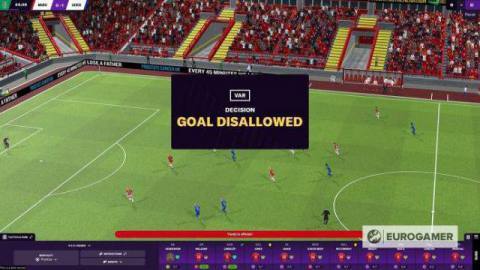
Arguably the largest change is to interactions, the collective name Sports Interactive gives to all of the conversations, meetings, and the like that you’ll have throughout the game. For more than a decade these have been organised as a kind of multiple-choice set of responses. Answer a question at a press conference or summon a player for a chat about their training efforts, and you’ll have a handful of preset things choose between saying, and six ‘tones’ with which you can say it: Calm, Cautious, Aggressive, Assertive, Reluctant, and Passionate. Now, tones are out and gestures are in, and there are thirty of them that the game pulls from each time you have an interaction. That alone isn’t too significant – if you’re a long-time user it’s possible to reverse-engineer what probably counts as Aggressive (throwing a water bottle in a half time team talk – frankly irresistible), or whatever else – but it combines nicely with other changes.
For one, press conferences are now presented in a 3D room, and there’s a little more to manage about them. There’s a general atmosphere to the room, a pre- and post-conference briefing with your club’s press officer, who might tell you the board wants you to avoid or mention something specific, and your relationship with the journalists, previously very ignorable, has been brought to the surface. The general vibe will need to be managed, with non-committal answers winding the journo’s up, sassy finger-waggles making them hostile, or a flash of that sparkling smile (hello again, Jurgen) normally enough to charm.

Press sentiment has always impacted the performances of your players and sentiment of the fans and board to some extent, but you’d have been forgiven for never knowing about it. The new conferences are a repositioning of the system that’s already there, but a smart one, and one that works. They can still drag – there are just so many press conferences – but a bit of visual flourish and clarity of the systems, coupled with a long overdue rewrite of the questions and answers, is enough to make the repetitiveness feel like an intentional reflection of conferences in real life – and the challenge managers face to stay both present and pleasant.
There’s a similar upgrade to team talks, which again work mostly the same way but have a nice new 3D dressing room, new gestures – again, when in doubt, always throw the water bottle – and new dialogue. A nitpick is the UI has changed such as to make giving individual team talks much slower, which is a pain for micro-managers. Instead of just selecting a drop-down team talk on a specific player, now every player is ‘ticked’ as included and you have to manually untick all thirteen-plus players who featured in the game, one by one, just to say ‘nice job’ to the standout performer. A tiny thing, hopefully improved in a post-beta patch, but still a drag that adds up over time – and pushes you away from using a feature instead of encouraging it.
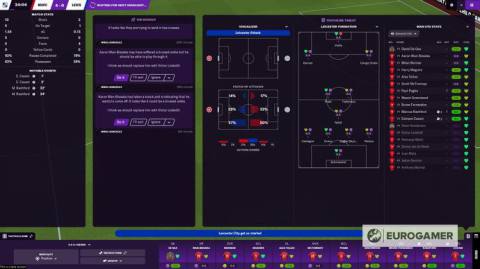
Still, new interactions continue. You can now have a ‘quick chat’ with someone, which bundles several pre-existing conversation types under a single name and differentiates them a little from others. These keep you on the current screen, offering a pop-up dialogue box over whatever you’re currently looking at, and work well to at least unify the experience. I’m a huge fan of the new ‘ask agent for availability’ one, a small addition that adds a huge amount of sleaze – and therefore realism – to the transfers system. There’s a reason why nobody mentions ‘tapping up’ any more: in today’s football you can just ask a player’s agent if they’re keen instead of the player themself. Football Manager felt a little old-fashioned in its proud refusal to budge from the have-an-offer-accepted-first system of waiting before you can truly find out. A huge time-saver, too: there’s no point chasing a player if they’re not remotely interested, or a 20-year-old who wants to be made captain. (I’m talking about you, Leon Bailey. Ridiculous).
If nothing else, FM21 is the chattiest, most animated edition in the series. But as impactful as all these new interactions may be, they’ve been trumped, for me, by something else. Something wonderful. Stats.
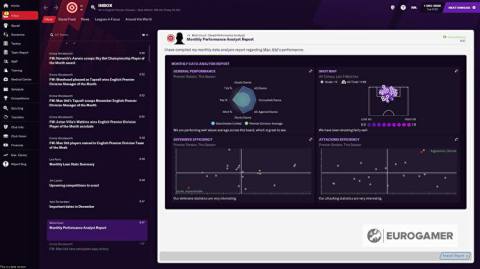
FM21 is fiercely nerdy, thanks to a revamp of the way in-game analysts show you data. If you haven’t noticed, I get very excited about data, but of equal importance to me and presumably every other data wonk worth their salt is how those stats are presented. FM21 absolutely gets this, and it’s glorious. Previously almost all of the data FM21 has was indeed there, but it was buried, even if your analyst had a full 20/20 rating for ‘Presenting Data’ themselves. The analysis screens were effectively giant data dumps – every pass in the game, every shot, every mistake, ready for you to personally narrow down and sift through – and the result, I’m guessing, is that most people ignored it. Now, you get a wonderful little summary before, during and after games that’s broken down into immediately useful visualisations.
The headliner is a new stat altogether, in the already-infamous xG, or expected goals. If you’re not familiar this is effectively a number given to how many goals your team should have scored according to the quality of the chances they made in a game. In the real world it’s usefulness is still very much up for debate, outside of the odd niche Twitter thread, because to most people ‘2.74 expected goals’ just doesn’t mean an awful lot. Game director Miles Jacobson also isn’t a fan.

As a result of that, Sports Interactive has resisted adding it for some time, but has finally done so here, with a twist. The studio built its own version from scratch, working with a company called Sci Sports. It includes things like defensive positioning that regular xG doesn’t, and the long and the short of it is FM21 now seems to have a better version of xG than real-world analysts. More importantly, it’s also handled beautifully in the game itself, with clear and surprisingly readable charts and diagrams showing when and where your best chances are coming from.
The best is what comes as a consequence of xG’s addition, though, as alongside it you’re also presented graphics on how ‘aggressive’ (how many clear chances you make) and ‘clinical’ (how good you are at taking them) your team is compared to everyone else in the competition – and likewise how ‘quiet’ and ‘impenetrable’ you are (how many chances you give up, and how many you concede in light of that). Again, cut through the noise and the result is a brilliant one: having clear data means having a clear idea of what you need to change. Aggressive but not clinical? Your striker’s underperforming, maybe because of a mental block or because he’s just not good enough at finishing. Clinical, but still not scoring enough? You need to be more aggressive in creating chances, so set your team up to take more risks. I could evangelise forever but, in brief, it’s excellent. Coming from someone who plays for hundreds of hours a year, more data plus clear graphics equals the best new feature in a decade.

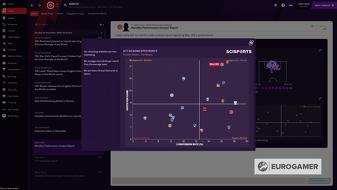
“But football isn’t about numbers!” I hear you say, wrongly. Well, worry not, because the match engine is much prettier and Sky Sportsier than ever. It’s another element to benefit from a fairly massive visual overhaul, and again the actual benefits go beyond the snazzy new lower thirds on the surface. For one, technical tweaks to the engine itself means players apparently make up to twice as many decisions per second – up to eight, from four, Sports Interactive says – and more interconnecting animations help show those decisions more smoothly. This is something that’s incredibly hard to test, but matches do feel more sophisticated, with some tidier midfield interplay for teams who aren’t just Man City or Liverpool and one or two genuinely beautiful flicks (Juan Mata’s been rolling back the years on may save) that do wonders for helping suspend the disbelief of an engine which is, despite its enormous sophistication under the hood, never going to be a total looker.
There’s also a big change to the managerial experience on matchday, and it’s another very effective one. During the match, you now have a bar along the bottom featuring your starting XI and an at-a-glance look at key info like their mindset, fatigue, and so on, with a very Ole Gunnar Solskjaer-y ‘touchline tablet’ to hand at all times for looking at analytics, formations and highlights in more detail. The changes here are mostly excellent – more realistic and more usable – minus a couple of minor things. Those elements like fatigue and mentality are more immediately visible at all times, but they are less helpful for those who prefer more detail.
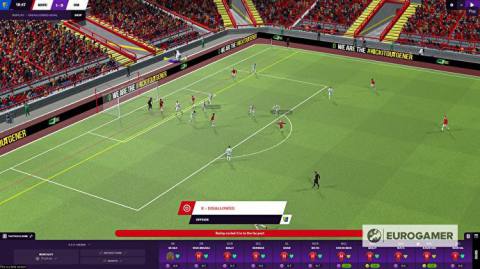
My go-to setup for matchday, for instance, was to have several overlays up on one side of the screen that go into more specific depth on each key thing, but under the new system that breadth of deep-diving overlays isn’t quite there. The new colour-coded smiley faces for mentality and emptying heart symbols for physical condition, for instance, mean you don’t have to go digging for the immediate impression – but if you do want the depth it’s harder to find. It’s another click to view each player’s actual mentality (frowny red face could be ‘anxious’ or ‘aggressive’ – two very different problems that need very different inputs from me to solve), while physical condition is no longer viewable as a percentage at all – arguably closer to the inexact science of real life, but also a tad harder to work around. And a few features I enjoyed, such as the ‘radar’, akin to the bottom-of-screen one in FIFA, that let you see top-down team shape a little easier, and the ability to scrub through the whole match’s timeline, don’t seem to be there at all.
But still, perspective. These are again very small nitpicks about very small things, which I’d imagine are rarely used. The overall effect is still more clarity than before, and I suspect much more visibility for systems newer or more casual players might not know about at all.


Finally, pre-match and post-match briefings are similarly more detailed, and I’m a big fan of the added post-match screens that show the reaction on social media, next to other results and a glimpse of the table. If you’ll let me get a little fancy about it, football is the phenomenon that it is because it has an uncanny ability to create drama. Seasons are year-long stories, complete with narrative arcs and grand, multi-decade journeys, and all the back pages and hashtags and little up and down movements in the table are equally essential parts of the whole. A little extra screen here and there – there’s also an end-of-season roundup – all add up, creating a growing sense of life around the game itself. This is where reality comes from, after all: the greater the presence of a living world around the thing you’re simulating, the more real that simulation feels. FM21 seems to get that, and remarkably well.
And that’s the magic of it, above everything else. This series has been a wonderful, remarkable thing for so long, and this year it was faced with an almighty challenge. I would’ve forgiven it for being a quieter one, had Sports Interactive understandably used the time to prep a little more for 2022, maybe tinker a little and just fix some minor things here and there. But it hasn’t. Not even slightly. FM21 is a massive step up from an already cracking year before. It’s hugely detailed and extremely well thought out. It’s nicer to look at, easier to understand, and easier to play, regardless of the depth with which you choose to play it. Just as a sim in itself, the sparkle of football placed aside, it’s a wonderful achievement. Football included? Sensational.
